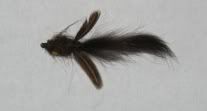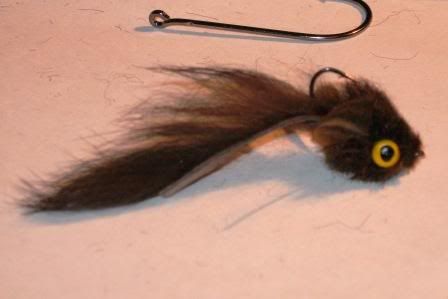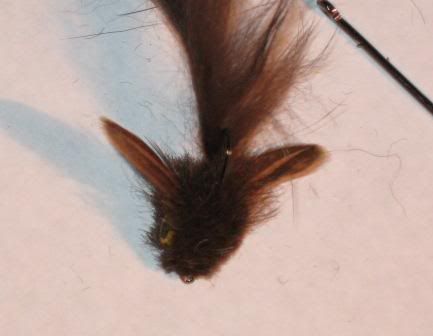So there have been a couple of things mentioned on here lately about both Alpaca wool and sculpins. I happen to have a rather large pile of alpaca because my girlfriend wants to learn to spin wool into yarn. Also, after a recent attempt at dying some feathers black for tying winged wets, I had a small tub of leftover dye. Now I had mixed the dye rather strong for dying the feathers and I really felt that there might be enough life left in it to do a decent job of dying a bit of the alpaca wool that I have laying about. Besides, I have never dyed alpaca and thought that this would be a great test to see how well it reacted with this particular brand of dye. So into the dye bath went a small hand full of the silver wool and the whole works went into the microwave for 2 minutes and then out onto the counter for the night. What was I planning to do with a bunch of black wool you ask? I have no idea, but I figured that I would deal with that when it became time…
So after a day and a half on the counter i was very politely reminded that my little tub of dye was still sitting in the kitchen. I went in, pulled out the fiber, and drained all the dye out of it. It looked as black as coal. The next step was the sink, where I ran it under cold water and pressed all of the remaining dye out of the mix. Now I had a small hair ball that appeared to me to be a very brown color. I dried it off in a paper towel and left it under a lamp to dry. When I came back to check on it, this is what I had…

What a great color! You’ll have to excuse my horrid camera work, but it’s a perfect, organic looking brown. Now what do I do with it? I decided to try my hand at tying a sculpin pattern since i have seen several requests on here for them. I honestly haven’t seen a sculpin in years, ever since we used to catch them on table rock when I was a kid. They were small, mottled brown, had a very large head and pectoral fins, and were generally regarded as a pain in the butt. We used to call them “bait stealers” because we very rarely caught one but could usually tell when one was messing with our line because we would get our baits stripped repeatedly.
Anyway, here is the sculpin that I came up with. I didn’t use anything as a pattern but it’s pretty basic so I am sure it’s been done before. Just in case I have put the recipe at the bottom. Tell me what you think and let me know any suggestions that you might have. Also, what do you think I should do with the rest of my brown alpaca?



Chris’s alpaca sculpin
Hook: gamakatsu B10s #6
Eyes: medium lead eyes tied clouser stye
Thread: 6/0 uni dark brown
Body: brown alpaca
Fins: brown india hen
Tail: dark brown rabbit zonker hooked on the hook through the skin side and tied in fur side towards the point of the hook.
Thanks for looking all,
Fish

